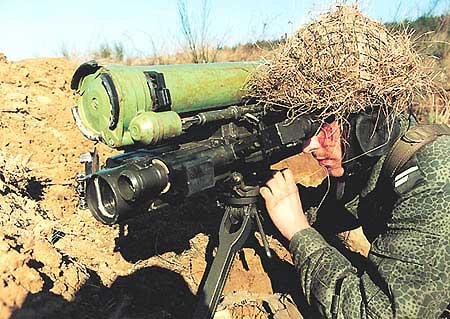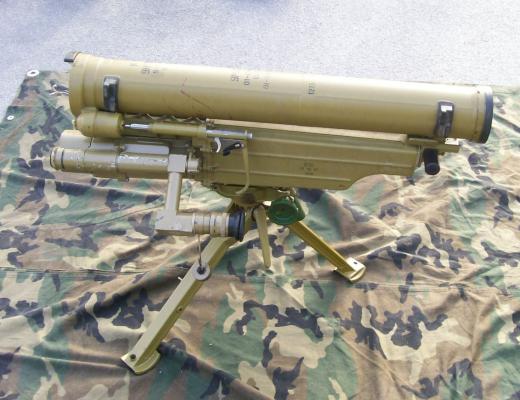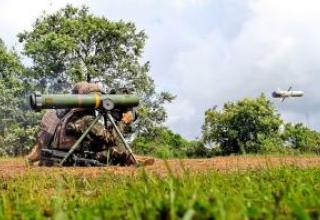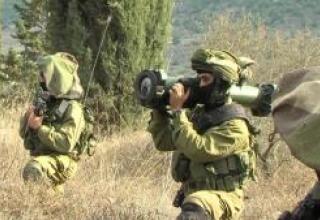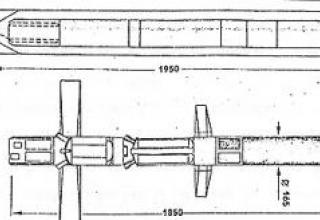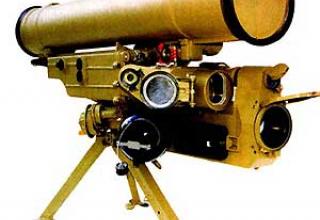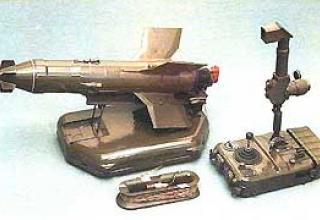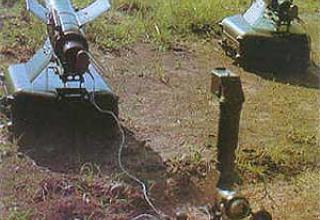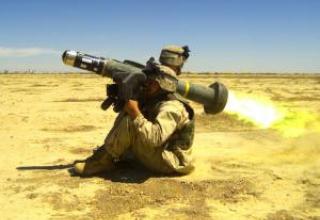Complex 9K115 with semi-automatic projectile control system is designed to engage visible stationary and moving at various course angles at a speed of up to 60 km / h armored targets at ranges from 40 to 1000 meters. The 9K115 complex also enables effective firing at firing points and other small targets.
The complex was developed in the Instrumentation Design Bureau (Tula) under the supervision of Chief Designer A.G. Shipunov and adopted for service in 1978.
In the west, the complex was designated AT-7 "Saxhorn" missile.
The 9K115 "Metis" complex was exported to many countries and used in many local conflicts of the last decades.
Composition:
It is part of the complex:
- guided missile 9M115
- 9P151 launcher (left view, right view, box view)
- To perform maintenance and current repair of the 9P151 starter unit, the 9B569 control and testing equipment as well as the 9B871-2 control and testing equipment are used. 9F640 simulator is used to train operators of 9K115 complex.
The 9M115 missile with a semi-automatic guidance system and a cumulative warhead is built according to the aerodynamic scheme "duck". The developers of the complex went to the ultimate simplification and facilitation of the disposable element of the complex - the missile, allowing some complexity of the repeatedly used ground guidance equipment. An important reserve for reducing the size, weight and cost of the PTUR was the simplification of onboard control system equipment. As it is known, ground-based hardware of semi-automatic guidance system of the PTUR determines the position of the missile by tracking devices connected with the ground coordinate system. Previously created samples of PTUR with single-channel control were equipped with gyroscopes that provide conversion of control signals from ground-based guidance equipment in commands formed with reference to the rotating with the missile coordinate system. The gyroscope was a rather expensive product. The 9M115 missile was equipped with a tracker mounted on one of its wings. When flying, the tracker moves in a spiral. Ground equipment receives information about the angular position of the PTUR, which allows you to properly adjust the commands issued to the controls of the missile on a wired line of communication.
In the forward part there are rudders with open air-dynamic drive using the air pressure of the raging flow. Absence of air or powder pressure accumulator, the use of plastic casting drive elements for main elements manufacturing reduces the drive cost many times in comparison with previously used products.
There are three trapezoidal wings in the tail of the missile. The wings are made of thin, flexible plates. During assembly, they are rolled up around the body without any residual deformations, after the exit of the missile from the TIC wings are straightened under the influence of elasticity . To launch the missile, a starting engine with a multi-power solid fuel charge is used.
The missile is delivered and operated in an airtight transport and launch container.
Launching device 9P151 folding, is a machine tool 9P152, lifting and rotary mechanism, which is installed control equipment - a guidance device 9C816 and hardware block. The starting device has a mechanism of precise pointing at the target, which reduces the requirements for the qualification of the operator.
At present the complex can be equipped with 1ПН86ВИ "Mulat-115" thermal sight for shooting at night and in smoky conditions. ("Falcon "2) developed by the NGO GIPO1 with a range of up to 1.5 km.
The complex consisting of one PP and four missiles is transferred in two wagons by two persons - the chief of calculation (the first number, aka the senior operator) and the operator (the second number). A 17 kg N1 pack with a launching device and one TPK with a rocket, and a N2 pack with three missiles in a 19.4 kg TPK (see diagram).
Shooting may be fired from prepared and unprepared positions from the lying position, from a trench, standing, as well as from the shoulder rest. It is also possible to fire from buildings (in the latter case, about 6 metres of free space at the rear).
Characteristics:
| Complex | |
| Range of fire, m | 40 - 1 000 |
| Probability of hitting a tank | 0,91 - 0,98 |
| Number of missiles in the complex | 4 |
| Calculation, man. | 2 |
| Transfer time of complex 9K115 (maximum), s: - from camping to combat - from combat to travel |
12 20 |
| From the moment the trigger is pressed until the shot is fired (time of firing), s, max. | 1,5 |
| Guided Jet Projectile 9M115 | |
| Range of effective firing, m: - minimum - maximum |
40 1000 |
| Time of projectile flight to maximum range, sec. | 5,6 |
| Average rocket speed, m/s | 180 |
| Maximum rocket speed, m/s | 223 |
| projectile rotation speed around longitudinal axis in flight, r./s. | 7 - 12 |
| Shell control | wireline |
| Интервал температур боевого применения снаряда 9М115, °С | ±50 |
| The dimensions of projectile 9M115, mm: | |
| - length | 784 |
| - width | 138 |
| - altitude | 145 |
| Weight of projectile 9M115, kg | 6 |
| Container caliber, mm | 93 |
| Charge length 9M116, mm | 733 |
| half-span stabilizer arm, mm | 187 |
| Weight of projectile 9M116, kg | 4,8 |
| Fighting unit | cumulative |
| Dimensions of the capping box 9Я55, mm | |
| - length | 925 |
| - width | 372 |
| - altitude | 427 |
| Weight of capping box 9Y55 with four shells 9M115, kg | 45 |
| Armor-piermeable, mm: - at an angle of 0° - at an angle of 60° |
500 - 550 250 |
| Starting device | |
| PU weight, kg | 10,0 |
| Starter weight 9П151 in box 9Я54, kg | 28 |
| Weight of the wagons, kg: | |
| - pack 1 (PU with shell 9M115) | 16,5 |
| - pack 2 (three rounds of 9M115) | 19 |
| Dimensions of the complex 9K115 (launch device 9P151 with the shell 9M115 mounted on it): | |
| in combat position (for firing from a tripod), m: - length - width - altitude |
0,865 0,4 0,525 |
| in a camping position, uh: - length - width - altitude |
0,810 0,225 0,360 |
| Launching device 9P151 provides firing, hail: - horizontally with reorientation of the PU - vertically, with front leg angle change PU |
round the clock between -15 and +15 |
| Angles of turning the PU guidance mechanisms, hail: - horizontally - vertically |
±30 ±5 |
| Technical rate of fire of 9K115 complex when shooting at one target at maximum range, vst./min. | 4-5 |
| Guidance device 9C816 | |
| Increase, fold | 6 |
| Visual channel field of view, degree. | 6 |
| Narrow field of view of the direction finding channel, min. | 40 |
Testing:
MTUR "Malyutka" was very successfully used during the Arab-Israeli War in 1973, it was with its help that almost the entire Israeli tank fleet was destroyed - about 800 vehicles. Only on October 6, 1973, for example, the 252nd Israeli Tank Division was defeated - more than a hundred vehicles were hit.
Sources:
- Ангельский Р.Д. "Отечественные противотанковые комплексы" -М: ООО "Издательство Астрель", 2002,-192с.
- Носимый противотанковый комплекс "Метис". Техническое описание 9К115.00.000 ТО. М.: Воениздат, 1984. - С.4-7. (Смотрите электронный вариант издания).
- "Российское ракетное оружие 1943-1993", А.В. Карпенко, СПб,"Пика", 1993
- Руководство по носимому противотанковому комплексу "Метис" (9К115). - М.: Воениздат, 1986. - С.4,54,55. (Смотрите электронный вариант издания).
- "ПТУРы сухопутных войск", Серия "Архив 500+" Киев, "Архив-Пресс",1997 г.
- Военный Парад
- Управляемый реактивный снаряд 9М115. Техническое описание и инструкция по эксплуатации 9М115.00.000ТО. - 1981 - С.6. (Смотрите электронный вариант издания).
